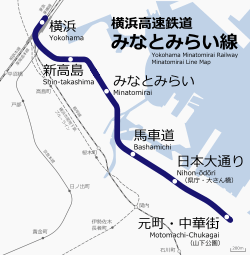Minatomirai Line
| Minatomirai Line | |||
|---|---|---|---|
|
| |||
 Y500 series rolling stock featuring a commemorative plaque on the day of the railway's opening | |||
| Overview | |||
| Type | Rapid transit | ||
| Locale | Yokohama | ||
| Termini |
Yokohama Motomachi-Chūkagai | ||
| Stations | 6 | ||
| Operation | |||
| Opened | 1 February 2004 | ||
| Owner | Yokohama Minatomirai Railway Company | ||
| Operator(s) | Yokohama Minatomirai Railway Company, Tokyu Corporation | ||
| Rolling stock | Y500 series | ||
| Technical | |||
| Line length | 4.1 km (2.5 mi) | ||
| Track gauge | 1,067 mm (3 ft 6 in) | ||
| Electrification | 1,500 V DC, overhead catenary | ||
| |||
The Minatomirai 21 Line (みなとみらい21線 Minato-mirai-21-sen), commonly known as the Minatomirai Line (みなとみらい線 Minatomirai-sen), is a subway line of the Yokohama Minatomirai Railway Company connecting Yokohama Station to Yokohama Chinatown through the Minato Mirai 21 development.
Service
With the exception of the first early-morning train which departs from Yokohama, all Minatomirai Line trains inter-run with the Tōkyū Tōyoko Line, and most offer direct service to/from Shibuya Station. Limited express trains from Shibuya Station to Motomachi-Chūkagai Station take a minimum of 33 minutes.
On special occasions, typically around holidays, the Tokyo Metro Hibiya Line and Namboku Line operate special Minatomirai (みなとみらい号), formerly known as Yokohama Mirai (横浜みらい号), direct through services to the Minatomirai Line. From 16 March 2013, the Tokyo Metro Fukutoshin Line also inter-runs to/from the Minatomirai Line.
Although the Minatomirai Line runs entirely underground, it is separate from the Yokohama Municipal Subway, which is operated by the Yokohama City Transportation Bureau.
Stations
Key:
- O: stop; |: pass
- EX: Express; CE: Commuter Express; LE: Limited Express; ST: S-Train (operated by Seibu; weekends only)
| No. | Station name | Local | EX | CE | LE | ST | Transfers |
|---|---|---|---|---|---|---|---|
| ↑ Through-running to/from TY Tokyu Toyoko Line, F Tokyo Metro Fukutoshin Line,TJ Tobu Tojo Line, and | |||||||
| Yokohama | O | O | O | O | O | ||
| Shin-Takashima | O | | | | | | | | | ||
| Minatomirai | O | O | O | O | O | ||
| Bashamichi | O | O | O | | | | | | |
| Nihon-ōdōri | O | O | O | | | | | ||
| Motomachi-Chūkagai | O | O | O | O | O | ||
Rolling stock
- Tokyu 5050 series 8-car EMUs
- Tokyu 5050-4000 series 10-car EMUs
- Y500 series 8-car EMUs
- Tokyo Metro 7000 series 8/10-car EMUs (since September 2012)
- Tokyo Metro 10000 series 8/10-car EMUs (since September 2012)
- Tobu 9000 series 10-car EMUs (since March 2013)
- Tobu 50070 series 10-car EMUs (since March 2013)
- Seibu 6000 series 10-car EMUs (since March 2013)
- Seibu 40000 series 10-car EMUs (since 25 March 2017)
 Tokyu 5050 series
Tokyu 5050 series Tokyu 5050-4000 series
Tokyu 5050-4000 series Y500 series
Y500 series Tokyo Metro 7000 series
Tokyo Metro 7000 series- Tokyo Metro 10000 series
- Tobu 9000 series
- Tobu 50070 series
- Seibu 6000 series
 Seibu 40000 series
Seibu 40000 series
History
Construction of the line started in 1993, and the line was finally opened to the public on February 1, 2004.
8-car Tokyo Metro 10000 series sets entered revenue service on the Minatomirai Line and Tokyu Toyoko Line from 7 September 2012.[1]
See also
References
- ↑ 東京メトロ10000系が東横線・みなとみらい線で営業運転を開始 [Tokyo Metro 10000 series enters revenue service on Tokyu Toyoko and Minato Mirai Line]. Japan Railfan Magazine Online (in Japanese). Japan: Koyusha Co., Ltd. 8 September 2012. Retrieved 11 September 2012.
External links
- Minatomirai Line Official Website (in Japanese)
